Views: 0
To Some Degree, Yes. Tea Tree Oil Is One of the Few “Natural” Treatments That Has Considerable Science Behind It.

The Essential Info
Tea tree oil is not a regular oil such as olive oil. Instead, it is an essential oil, which is a different type of oil that contains the “essence” of a plant. This means essential oils contain the important chemicals inside a plant.
Because essential oils contain the essence of a plant, they normally have a strong scent. Tea tree oil is no exception and comes with a very potent fragrance.
Tea tree oil is isolated from the leaves of the tea tree (Melaleuca alternifolia), and contains an active compound called terpinin-4-ol, which is responsible for its healing properties. Terpinin-4-ol is:
- Anti-inflammatory (most important): Acne is a chronic inflammatory disease, so anything that reduces inflammation is welcome.
- Antibacterial: Acne is in part a bacterial disease, so anything that can kill or limit the growth of bacteria is also welcome.
Tea tree oil is a safe and somewhat effective topical treatment for acne with fewer side effects than most prescription medications, but it does not completely clear acne, so keep your expectations grounded.
Most studies of tea tree oil use it at around 5% strength. In the real world, this means using only a couple of drops of tea tree oil each time you use it. It can be mixed into a non-pore-clogging moisturizer, or any existing topical acne treatment.

The Science
Tea tree oil is a “natural” acne remedy that should produce at least some reduction in acne through its proven anti-inflammatory and antibacterial effects. However, it is likely the anti-inflammatory effect that helps reduce acne the most.
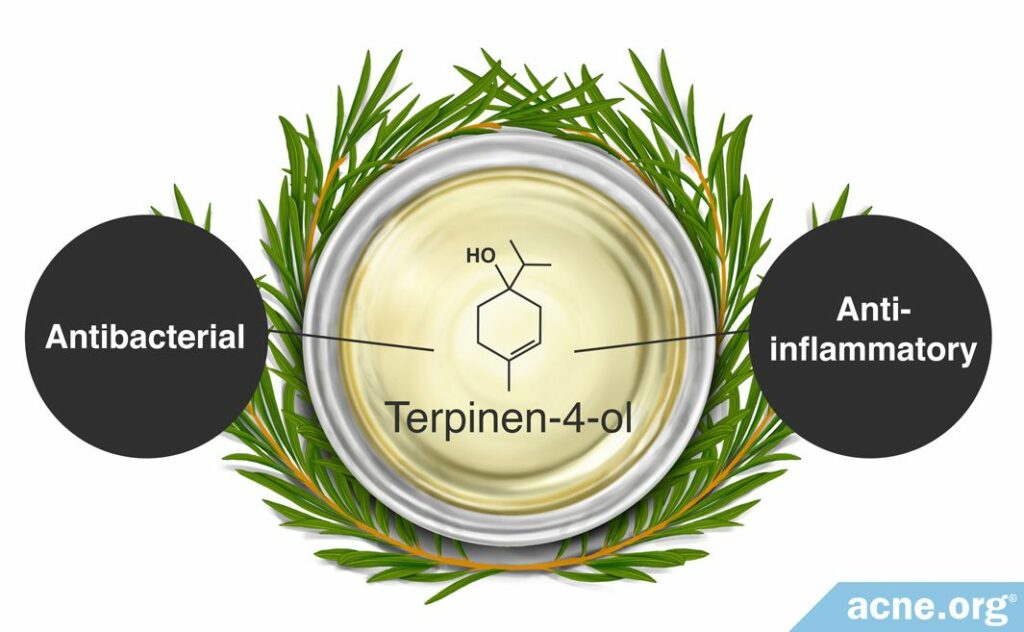
Anti-inflammatory effect: A chemical in this naturally-occurring oil, called terpinen-4-ol, blocks molecules that cause inflammation in the skin, thereby reducing the swelling and inflammation in acne lesions.
Antibacterial effect: Terpinen-4-ol also kills some of the bacteria found in acne lesions, called Cutibacterium acnes (C. acnes) by breaking down the bacteria’s cell membrane. However, tea tree oil’s prowess at killing bacteria is much more impressive in the lab than it is in human skin. In other words, scientists have seen tea tree oil kill bacteria in a petri dish very well, but find that it has a harder time killing bacteria when applied to human skin.1-3
How Effective Is Tea Tree Oil?
Three studies have shown that tea tree oil can significantly reduce acne lesions, and is 3 – 5X more effective than a placebo. In other words, it appears to be the real deal. However, these studies also showed that acne was not completely cleared, so don’t expect a dramatic improvement or completely clear skin if using only tea tree oil to treat acne.
Expand to read details of studies on tea tree oil’s effectiveness

One clinical study published in the Journal of Convergence Information Technology in 2013 looked at how effectively tea tree oil combined with lavender oil and jojoba oil treated acne. Scientists divided 54 college students into two groups. The researchers gave the first group a standard acne treatment as well as the tea tree, lavender, and jojoba oils treatment twice a day for four weeks. The second group was given only the standard treatment. All the students applied the treatments twice daily for four weeks. Those adding the oils to their treatment “showed significant decreases in both non-inflammatory and inflammatory lesions, whereas the control group showed a significant decrease of only the non-inflammatory lesions.“The group using the oils also saw a 12% reduction in sebum production while the other group did not.”2

In another study, published in the Indian Journal of Dermatology, Venereology and Leprology in 2007, subjects with acne applied tea tree oil as a topical 5% gel treatment twice daily for 45 days. Scientists then compared the subjects’ skin with a group of people who had applied a placebo gel containing no active ingredients. They found that the group applying the tea tree oil gel saw a significant reduction in acne lesions. “The mean total acne lesions in the 5% tea tree oil group reduced from 21.16 before treatment to 11.33 after six weeks of treatment, a reduction of 43.64%…In terms of total acne lesions and acne severity index, tea tree oil gel was 3.55 times and 5.75 times more effective than placebo respectively. Side-effects with both groups were relatively similar and tolerable.”4

Another study, published in the Australasian Journal of Dermatology in 2017, tested the efficacy of a tea tree oil gel as well as tea tree oil face wash at treating mild-to-moderate acne. The 14 patients who participated in the study applied both products daily for 12 weeks. The researchers evaluated the patients’ acne after 4, 8, and 12 weeks of treatment and found significant improvement. They also noted that the tea tree oil products caused only minor skin irritation in some patients, which disappeared on its own. The scientists wrote, “This study shows that the use of the tea tree oil products significantly improved mild to moderate acne and that the products were well tolerated.”5
When it comes to combining tea tree oil with other acne treatments, one study offers some encouraging evidence. In this study, researchers combined tea tree oil with adapalene, a topical retinoid that is often prescribed for acne, and found that the combination was much more effective than adapalene alone. Of course, this is only one study, and more research will be necessary to confirm these findings.
Expand to read details of study
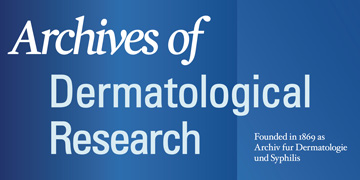
This study was published in the Archives of Dermatological Research in 2022. The researchers randomly divided 100 people with acne into 2 groups:
- Group 1 included 53 people who applied 0.1% adapalene gel + a thin film of tea tree oil to their skin once a night for 12 weeks.
- Group 2 included 47 people who applied 0.1% adapalene gel by itself to the skin once a night for 12 weeks.
The researchers examined the patients’ skin for improvement 4, 8, and 12 weeks after starting this treatment. They found a significant improvement in acne in both groups. However, Group 1, which applied the tea tree oil in addition to adapalene, experienced dramatically better results than Group 2. Based on the degree of acne improvement, the researchers considered 71.69% of patients in Group 1 to have achieved treatment success, compared to only 6.38% of patients in Group 2. Thus, the scientists concluded that adding tea tree oil to standard acne treatments such as adapalene might produce better results for people with acne.6
For an apples to apples comparison, scientists have also pitted tea tree oil against common acne treatments. It was shown to be more effective than the topical antibiotic erythromycin, but less effective than benzoyl peroxide.
Tea tree oil vs. Erythromycin
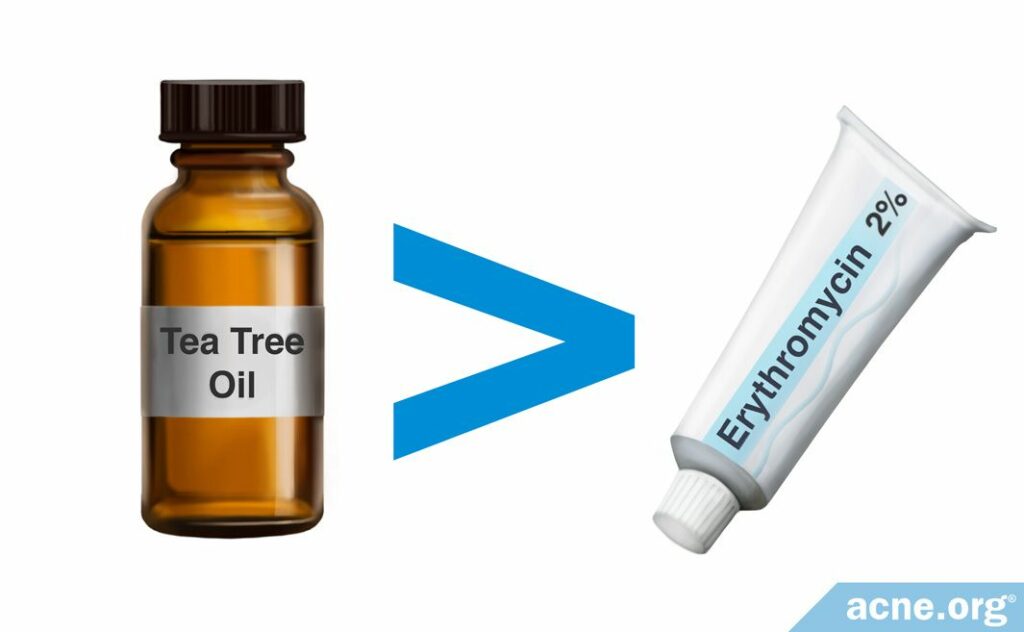
Tea tree oil was shown to be moderately more effective than erythromycin, a commonly prescribed topical antibiotic for acne. Tea tree oil also has a vastly improved safety profile when compared with erythromycin, and has fewer adverse effects. But again, the evidence shows that tea tree oil can only moderately reduce acne, and not eliminate it.
Expand to read details of studies

One clinical study found that tea tree oil reduced acne lesions by 55%, compared to 40% for erythromycin. The researchers asked 60 patients with mild to moderate acne to apply either a 5% tea tree oil gel or a 2% erythromycin gel twice daily for six weeks. “Lesion numbers were reduced by more than 50% from baseline for 87.5% of patients in the tea tree oil group and 53.8% of patients in the erythromycin group. Frequencies of side effects did not differ significantly between groups, however there were significantly more withdrawals due to adverse events in the erythromycin group,” reported the researchers.7

While tea tree oil can be somewhat irritating to a small percentage of people, and can cause allergy in rare events, overall tree oil presents fewer side effects than other treatments. The author of a review article on tea tree oil-containing products said that its side effects “are typical events for topically applied acne treatments and occurred at similar, or lower, rates than the other medicated acne products…Previous patch test studies with human volunteers demonstrated that tea tree oil has both irritant and allergenic potential, although rates for both are low.”7
Tea tree oil vs. Benzoyl peroxide
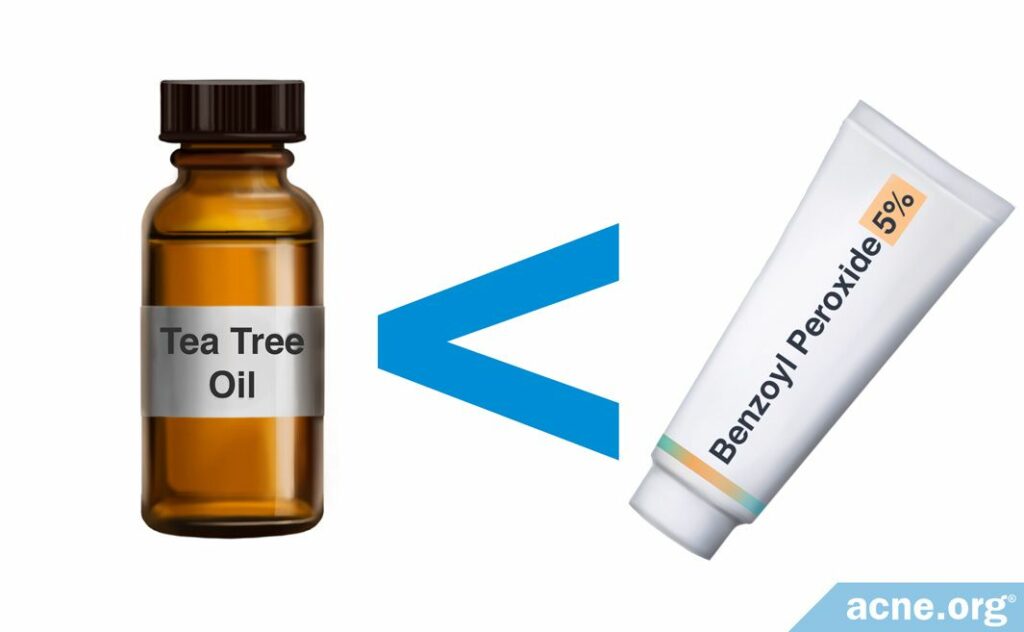
When tea tree oil went up against benzoyl peroxide, it did not compare quite as well, and benzoyl peroxide was significantly more effective. However, benzoyl peroxide, when used correctly, is capable of completely clearing the skin, so even competing in the same battleground is a feather in tea tree oil’s cap.
Expand to read details of study

Research shows that although tea tree oil has fewer side effects than benzoyl peroxide, it is less clinically effective for treating acne.6 A clinical study compared the effects of the two treatments, in which patients applied either 5% tea tree oil or 5% benzoyl peroxide treatment twice daily for eight weeks. Tea tree oil reduced inflammatory lesions by 49% compared to 68% for benzoyl peroxide.9
A reviewer of the research pointed out the importance of the fact that “significantly fewer overall side effects were reported by the TTO [tea tree oil] group (27 of 61 patients) than by the BP [benzoyl peroxide] group (50 of 63 patients).”9
Interestingly, the 2 treatments also had slightly different effects on the skin. “The BP group showed significantly less oiliness than the TTO group, whereas the TTO group showed significantly less scaling, [itching], and dryness,” reported the reviewer.9
Another welcome characteristic of tea tree oil is how it does not create colonies of resistant bacteria, like antibiotics can.
Expand to read details about how tea tree oil does not create resistant bacteria
Acne bacteria is becoming increasingly resistant to topical and oral antibiotics. Because this resistant bacteria is easily spread through direct contact from person to person, over 50% of people now harbor resistant bacteria in their skin. The result is that traditional antibiotic treatments for acne are becoming less effective. The graphic below shows how antibiotics can create resistant bacteria, while tree oil does not.
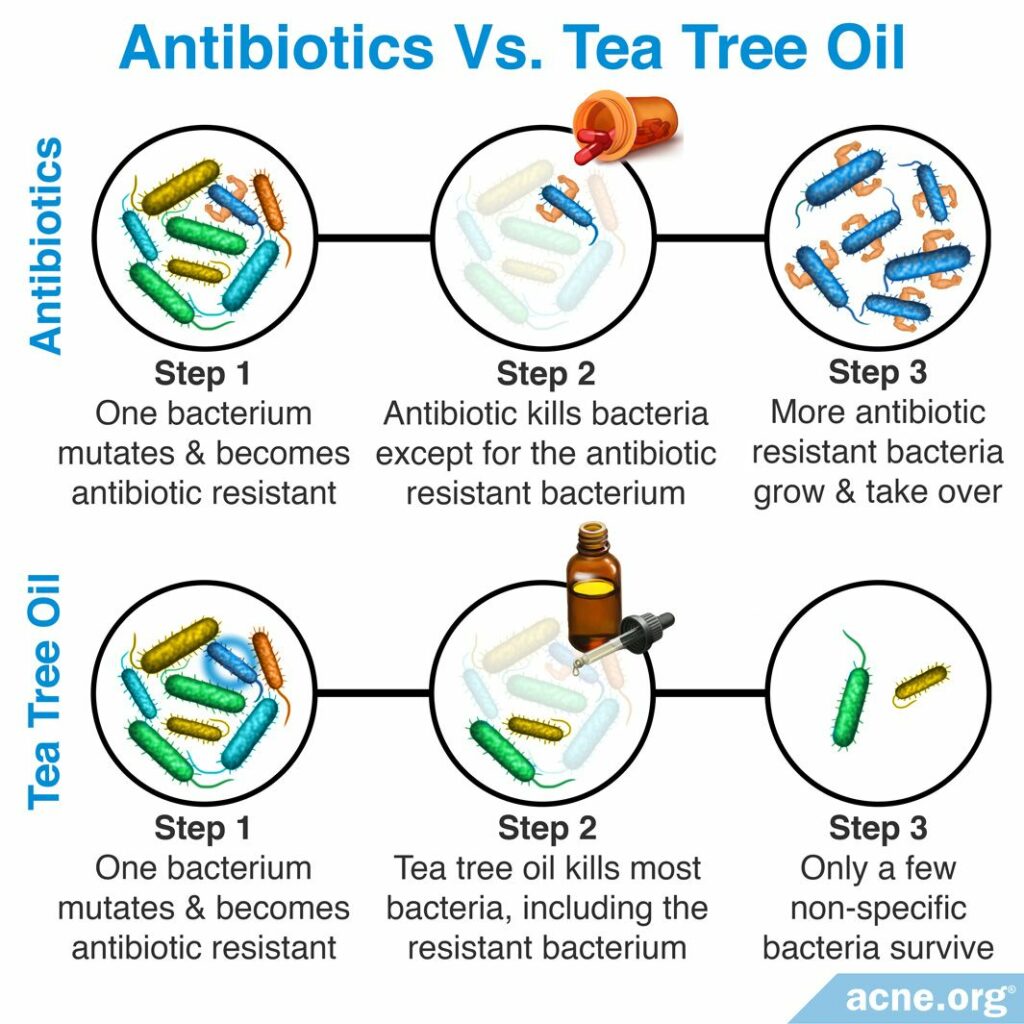
Scientists have not yet studied whether tea tree oil specifically prevents acne bacteria (C. acnes) from becoming resistant. However, we do know that tea tree oil can kill these bacteria in the lab once they have become resistant to antibiotics. According to a 2019 study published in the Saudi Journal of Biological Sciences, tea tree oil killed antibiotic-resistant C. acnes in a petri dish within 4 hours. The scientists wrote that they consider tea tree oil a good candidate to replace antibiotics in acne treatment.9
Research has shown that tea tree oil does seem to prevent antibiotic resistance in other, tougher bacteria such as MRSA (methicillin-resistant Staphylococcus aureus). This suggests that tea tree oil could also prevent C. acnes from developing resistance: According to a 2006 review in the journal Clinical Microbiology Reviews, “It is likely that the multicomponent nature of TTO [tea tree oil] may reduce the potential for resistance to occur spontaneously, since multiple simultaneous mutations may be required to overcome all of the antimicrobial actions of each of the components.”10
One group of researchers found that tea tree oil did not induce resistance in a variety of bacteria that had already developed resistance to classic antibiotics. Scientists reviewing this study added, “This is not the only work to suggest that exposure to tea tree oil does not induce resistance to itself or to other antimicrobial agents. Previous data showed that S. aureus, hypermutable strains of S. aureus, S. epidermidis, Staphylococcus sp. and Enterococcus faecalis all had very low frequencies of resistance to tea tree oil.”11
In other words, because bacteria are unlikely to become resistant to the effects of tea tree oil, this means that it should continue to be a useful treatment, long after antibiotics have been rendered useless.
Side Effects of Tea Tree Oil
Tea tree oil is generally considered safe when used in recommended doses of up to 5%.
The most commonly reported side effects are skin irritation and mild burning.
Some studies in Australia have found that tea tree oil frequently causes allergic reactions, but studies in other countries suggest the likelihood of an allergic reaction is low. Scientists speculate that allergic reactions probably occur with old tea tree oil that has been left exposed to the air for a long time. Further research will be necessary to confirm this idea.12
To be on the safe side, if you decide to try tea tree oil, do not use it at 100% strength right out of the bottle. Instead, be sure to dilute it by putting a couple of drops into a facial moisturizer or other topical product and monitor your skin for signs of an allergic reaction.
How To Use It
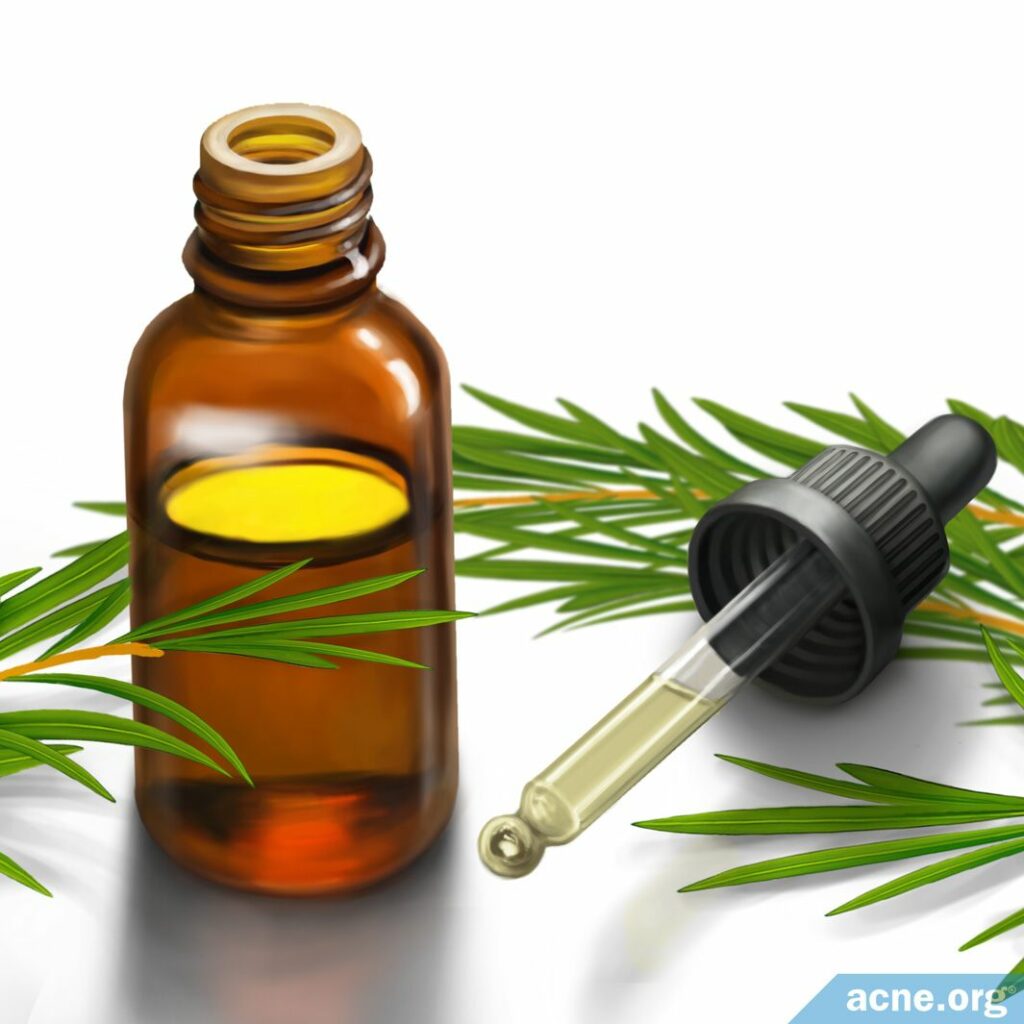
When using tea tree oil, be forewarned that it has a strong and distinctive scent.
Most studies have been performed using about 5% strength tea tree oil, which equates to only a couple of drops each time you use it. You can simply dispense a couple drops into your palm and mix it with a non-comedogenic (won’t clog pores) facial moisturizer, and apply.
Alternatively, you can dispense a couple of drops into your palm and mix it with whichever topical acne treatment you are currently using.
How I use it: I like to mix two drops into my moisturizer on occasion. But I must admit the scent packs such a punch that I don’t find myself using it every day.
References
- Khalil Z, et al. “Regulation of wheal and flare by tea tree oil: complementary human and rodent studies.” The Journal of Investigative Dermatology. 2004; 123: 683 – 90. https://www.ncbi.nlm.nih.gov/pubmed/15373773
- Kim BY, Shin S. “Antimicrobial and Improvement Effects of Tea Tree and Lavender Oils on Acne Lesions.” Journal of Convergence Information Technology. 2013; 8: 339-345. http://cms.herbalgram.org/herbclip/561/071636-561.html?ts=1574025837&signature=5dd94f92119982b8d3ab105b37f4ea08
- Nascimento T, Gomes D, Simões R. & da Graça Miguel M. Tea tree oil: Properties and the therapeutic approach to acne—a review. Antioxidants (Basel). 2023; 12: 1264 -1311. https://pubmed.ncbi.nlm.nih.gov/37033604/
- Enshaieh S, et al. “The efficacy of 5% topical tea tree oil gel in mild to moderate acne vulgaris: a randomized, double-blind placebo-controlled study.” Indian Journal of Dermatology, Venereology and Leprology. 2007; 73: 22 – 25. https://www.ncbi.nlm.nih.gov/pubmed/17314442
- Malhi HK, Tu J, Riley TV, Kumarasinghe SP, and Hammer KA. “Tea tree oil gel for mild to moderate acne; a 12 week uncontrolled, open-label phase II pilot study.” Australasian Journal of Dermatology. 2017; 58: 205-210. https://www.ncbi.nlm.nih.gov/pubmed/27000386
- Najafi-Taher R, Jafarzadeh Kohneloo A, Eslami Farsani V, Mehdizade Rayeni N, Moghimi HR, Ehsani A & Amani A. A topical gel of tea tree oil nanoemulsion containing adapalene versus adapalene marketed gel in patients with acne vulgaris: a randomized clinical trial. Archives of Dermatological Research. 2022; 314: 673-679. https://pubmed.ncbi.nlm.nih.gov/34251536/
- Hammer K. “Treatment of acne with tea tree oil (melaleuca) products: A review of efficacy, tolerability and potential modes of action.” International Journal of Antimicrobial Agents. 2015; 45: 106 – 110. https://www.ncbi.nlm.nih.gov/pubmed/25465857
- Bassett IB, Pannowitz DL, and Barnetson RS. “A comparative study of tea-tree oil versus benzoyl peroxide in the treatment of acne.” The Medical Journal of Australia. 1990; 153: 455 – 458. https://www.ncbi.nlm.nih.gov/pmc/articles/PMC3366450/
- Esmael A, Hassan MG, Amer MM, Abdelrahman S, Hamed AM, Abd-Raboh HA, and Foda MF. “Antimicrobial activity of certain natural-based plant oils against the antibiotic-resistant acne bacteria.” Saudi Journal of Biological Sciences. 2020; 27: 448-455. https://www.sciencedirect.com/science/article/pii/S1319562X19302414
- Carson CF, Hammer K, and Riley TV. “Melaleuca alternifolia (Tea Tree) oil: a review of antimicrobial and other medicinal properties.” Clinical Microbiology Reviews. 2006; 19: 50 – 62. https://www.ncbi.nlm.nih.gov/pubmed/16418522
- Thomsen N, et al. “Effect of habituation to tea tree (Melaleuca alternifolia) oil on the subsequent susceptibility of Staphylococcus spp.to antimicrobials, triclosan, tea tree oil, terpinen-4-ol and carvacrol.” International Journal of Antimicrobial Agents. 2013; 41: 343 – 351. https://www.ncbi.nlm.nih.gov/pubmed/23481659
- Kairey L, Agnew T, Bowles EJ, Barkla BJ, Wardle J & Lauche R. Efficacy and safety of Melaleuca alternifolia (tea tree) oil for human health—A systematic review of randomized controlled trials. Frontiers in Pharmacology. 2023; 14: 1116077. https://pubmed.ncbi.nlm.nih.gov/37033604/
The post Does Tea Tree Oil Really Work to Clear Acne? appeared first on Acne.org.

